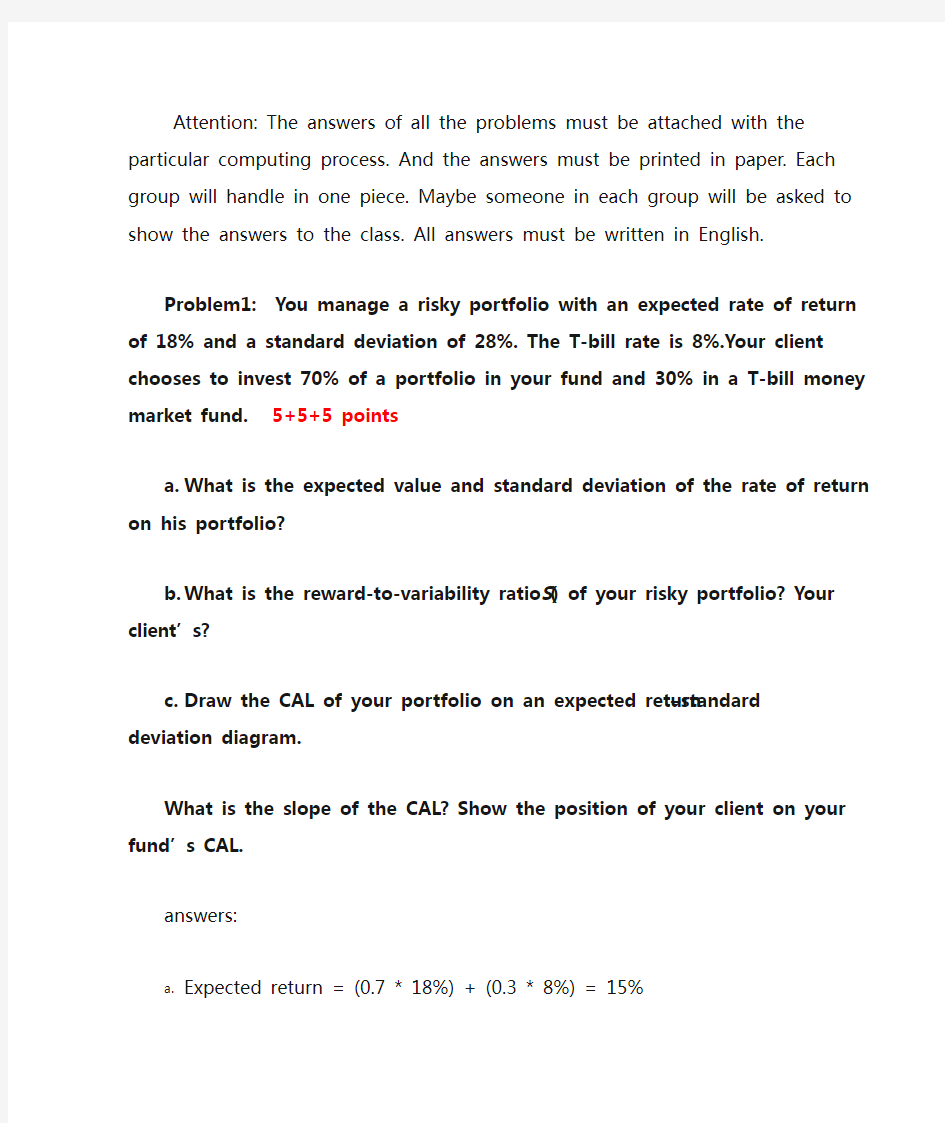homework-ch7-answers


Attention: The answers of all the problems must be attached with the particular computing process. And the answers must be printed in paper. Each group will handle in one piece. Maybe someone in each group will be asked to show the answers to the class. All answers must be written in English.
Problem1:You manage a risky portfolio with an expected rate of return of 18% and a standard deviation of 28%. The T-bill rate is 8%.Your client chooses to invest 70% of a portfolio in your fund and 30% in a T-bill money market fund. 5+5+5 points
a.What is the expected value and standard deviation of the rate of return on his
portfolio?
b.What is the reward-to-variability ratio (S) of your risky portfolio? Your client’s?
c.Draw the CAL of your portfolio on an expected return–standard deviation diagram.
What is the slope of the CAL? Show the position of your client on your fund’s CAL. answers:
a.Expected return = (0.7 * 18%) + (0.3 * 8%) = 15%
Standard deviation = 0.7 * 28% = 19.6%
b.
c.
Problem2: You manage a risky portfolio with an expected rate of return of 18% and a standard deviation of 28%. The T-bill rate is 8%.You estimate that a passive portfolio, that is, one invested in a risky portfolio that mimics the S&P 500 stock index, yields an expected rate of return of 13% with a standard deviation of 25%. 5+5 points
a.Draw the CML and your funds’CAL on an expected return–standard deviation diagram.
b.Characterize in one short paragraph the advantage of your fund over the passive fund.
answers:
a.S CAL=(18%-8%)/28%=.3771,
S CML=(13%-8%)/25%=.2
b.My fund allows an investor to achieve a higher mean for any given standard deviation than would a passive strategy, i.e., a higher expected return for any given level of risk.
Problem3: You manage a risky portfolio with an expected rate of return of 18% and a standard deviation of 28%. The T-bill rate is 8%.Your client chooses to invest 70% of a portfolio in your fund and 30% in a T-bill money market fund.There is a passive portfolio,that is, one invested in a risky portfolio that mimics the S&P 500 stock index, yields an expected rate of return of 13% with a standard deviation of 25%.Your client ponders whether to switch the 70% that is invested in your fund to the passive portfolio.
Explain to your client the disadvantage of the switch.10 points
Hint:given the same return or risk, we can compare the risk or return then choose the portfolio which has a lower risk or higher return.
answers:
With 70% of his money invested in my fund’s portfolio, the client’s expected return is
15% (=8%+.7*(18%-8%))per year and standard deviation is 19.6%(=.7*28%) per year. If
he shifts that money to the passive portfolio (which has an expected return of 13% and
standard deviation of 25%), his overall expected return becomes:
E(rC) = rf + 0.7[E(rM)-rf] = 8 + [0.7 * (13 – 8)] = 11.5%
The standard deviation of the complete portfolio using the passive portfolio would be: σC = 0.7*σM = 0.7*25% = 17.5%
Therefore, the shift entails a decrease in mean from 15% to 11.5% and a decrease in standard deviation from 19.6% to 17.5%. Since both mean return and standard deviation decrease, it is not yet clear whether the move is beneficial.
The disadvantage of the shift is that, if the client is willing to accept a mean-return on his total portfolio of 11.5%, he can achieve it with a lower standard deviation using my fund rather than the passive portfolio.
To achieve a target mean of 11.5%, we first write the mean of the complete portfolio as a function of the proportion invested in my fund (y):
E(rC) = 8 + y(18- 8) = 8 + 10y
Our target is: E(rC) = 11.5%. Therefore, the proportion that must be invested in
my fund is determined as follows:
The standard deviation of this portfolio would be:
σC = y*28% =0.35*28%=9.8%
Thus, by using my portfolio, the same 11.5% expected return can be achieved with a standard deviation of only 9.8% as opposed to the standard deviation of 17.5% using the passive portfolio.
Problem5(*):You manage an equity fund with an expected risk premium of 10% and an expected standard deviation of 14%. The rate on Treasury bills is 6%. Your client chooses to invest $60,000 of her portfolio in your equity fund and $40,000 in a T-bill money market fund. What is the expected return and standard deviation of return on your client’s portfolio?
5+5 points
answers: c
Expected return for equity fund = T-bill rate + risk premium = 6% + 10% = 16%
Expected return of c lient’s overall portfolio = (0.6*16%) + (0.4*6%) = 12%
Standard deviation of client’s overall portfolio = 0.6*14% = 8.4%
Problem6(*):What is the reward-to-variability ratio for the equity fund in problem 5?
a. .71.
b. 1.00.
c. 1.19.
d. 1.91.(group 4)
answers: a
